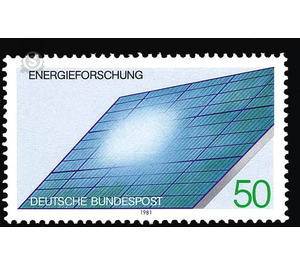energy research - Germany / Federal Republic of Germany 1981 - 50 Pfennig
Theme: Economy & Industry
| Country | Germany / Federal Republic of Germany |
| Issue Date | 1981 |
| Face Value | 50.00 |
| Color | blue |
| Perforation | K 14:14 1/4 |
| Printing Type | Six-color offset printing |
| Stamp Type | Postage stamp |
| Item Type | Stamp |
| Chronological Issue Number | 974 |
| Chronological Chapter | GER-BRD |
| SID | 789069 |
| In 35 Wishlists | |
Sufficient availability of technically and scientifically usable energy is a key factor in maintaining and improving the performance and competitiveness of the German economy, because all areas of our lives - from industrial and agricultural production to the service sector and individual lifestyle - are concentrated on one sufficient energy supply are dependent. Energy is not only a prerequisite, but at the same time a limiting factor for the prosperity of the citizens of our country. Many of today's predominantly used fossil fuels will be exhausted within the foreseeable future. It is therefore increasingly important to study all sources of energy that may be considered for future use and to promote developments in their exploitation. Energy research is thus an important element of government research and technology policy to increase the security of energy supply in the Federal Republic of Germany in the long term. Immediately after the oil crisis in 1973/74, the German Federal Government attached importance to energy research to the adoption of a framework program "Energy Research 1974-1977" and in the spring of 1977 an update program "Energy Research and Energy Technologies 1977-1980" is a self-contained concept for R & D across the energy sector. It covers the areas of energy use, energy conversion and energy provision with the following four priorities: - rational use of energy, - coal technologies, - new sources of energy, - nuclear energy. Of the new sources of energy, solar energy and the energy sources derived from it have rapidly gained in importance in the short time of development to date for their use. In the long term, it has the great advantages of not being bound to resources of the earth and causing no additional heat or pollutant load. The amount of energy injected into the territory of the Federal Republic of Germany corresponds to about 70 times the primary energy input obtained from exhaustible energy sources, but only a small part of it will be usable under currently foreseeable technical and scientific conditions. Solar energy can be technically exploited by - photothermal conversion to heat supply, - photovoltaic or photothermal conversion for electricity generation, - biological and chemical conversion to produce hydrocarbons, - photolytic conversion to hydrogen production. With the help of photocells (photovoltaic conversion), the solar radiation can be directly converted into electrical energy. In the past, this has been successfully used in aerospace satellite power supply. Economic considerations play a decisive role in space applications in earth-bound cells. The research and development efforts worldwide focus mainly on photocells based on monocrystalline and polycrystalline silicon. The goal here is to achieve a significant cost reduction, both through the further development or extensive automation of the cell manufacturing technology as well as by novel semiconductor base material manufacturing methods. In the photovoltaic solar generator shown in the motif efficiencies of 10% can be achieved when using polycrystalline silicon cells. The development of low-cost cell types on this basis opens up new opportunities to extend the economic scope of photocells to use solar energy. The main areas of application are seen in the power supply of measuring stations for land and sea use, telecommunications equipment, traffic signal systems and independent power supply systems in sunny regions to some 100 kilowatts of power. (Text: Federal Ministry of Research and Technology)


